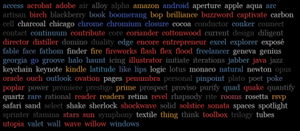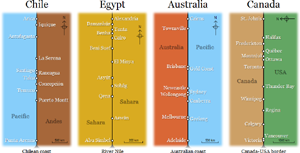Inorganic Molecules
Notes
This representation of 451 inorganic compounds shows how positive and negative ions combine to form simple molecules
Molecules are simple, right? A metal atom has a few complete shells of electrons, with one or two electrons to spare. A non-metal atom has a few complete shells of electrons, plus one shell that needs one or two more electrons to be complete.
So they get together. The metal atom donates those spare electrons, becoming positive. The non-metal atom receives them, becoming negative. Opposites attract, and the metal and the non-metal remain bound, a marriage made in heaven.
Well, maybe not so simple. Even if you forgive my over-simplification of the physics (electrons don't really orbit nuclei in shells, and they aren't really donated from one atom to another), things quickly become complicated.
A sodium atom has one too many electrons, and a chlorine atom has one too few, so their pre-nuptial agreement is pretty straightforward, and they get together, one-on-one, to form a sodium chloride molecule, or salt.
A hydrogen atom, too, has one too many electrons, but an oxygen atom has two too few, so oxygen needs two hydrogen atoms to tempt it into a relationship to form H2O, or water. Among atoms, monogamy is not the norm.
And it only gets more complicated from there. Ammonium bicarbonate is a union between a nitrogen atom, five hydrogen atoms, a carbon atom and three oxygen atoms.
This chart shows metal ions top-to-bottom, non-metal ions left-to-right, and combinations of each with each of the others in the middle.
451 of these molecules, included in Wikipedia's List of inorganic compounds, are shown with links to the Wikipedia article on that compound. If the article is long, suggesting an interesting compound (salt, water, etc.), the molecule is shown a strong shade of green; if the article is shorter (beryllium sulphite, niobium oxychloride, etc.), the shade of green is less strong.
Another 3198 hypothetical molecules are shown in pale green with pale text. These molecules may or may not exist in nature. If you ever come across, say, an osmium carbide molecule, do let me know!
Subscribe now and I’ll let you know whenever I create a new visualization
It’ll only be every couple of months or so, I won’t let anyone else have your email address, and you can unsubscribe at any time
Thanks for subscribing!
Check your inbox for an email to confirm your subscription
Oh no, something went wrong, and I was unable to subscribe you!
Please refresh your browser and try again
More
This is one of a series of visualizations of what things are made of, from elementary particles to organic molecules…
Inorganic Molecules – this page
…check back soon for the next in the series
Latest things made thinkable
Date
First published 25 January 2015












Comments
Click here to leave a comment
Thanks for your comment!
I’ll check it and put it live as soon as I can
Oh no, something went wrong, and I was unable to post your comment!
Please refresh your browser and try again